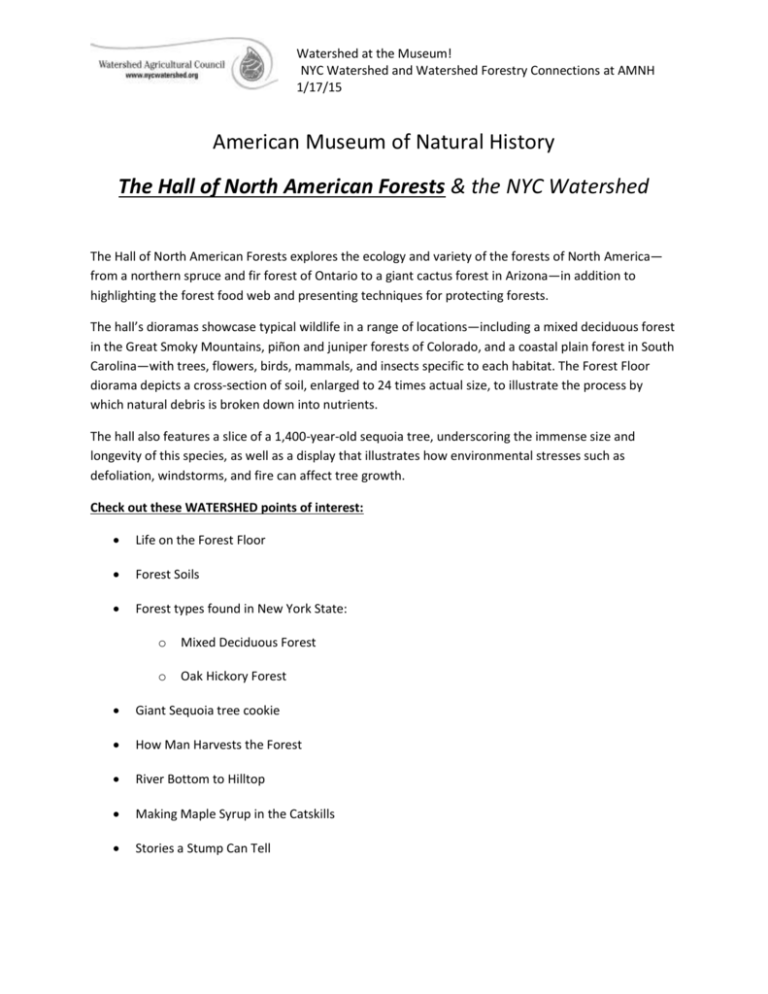North American Forests Exhibit
advertisement

Watershed at the Museum! NYC Watershed and Watershed Forestry Connections at AMNH 1/17/15 American Museum of Natural History The Hall of North American Forests & the NYC Watershed The Hall of North American Forests explores the ecology and variety of the forests of North America— from a northern spruce and fir forest of Ontario to a giant cactus forest in Arizona—in addition to highlighting the forest food web and presenting techniques for protecting forests. The hall’s dioramas showcase typical wildlife in a range of locations—including a mixed deciduous forest in the Great Smoky Mountains, piñon and juniper forests of Colorado, and a coastal plain forest in South Carolina—with trees, flowers, birds, mammals, and insects specific to each habitat. The Forest Floor diorama depicts a cross-section of soil, enlarged to 24 times actual size, to illustrate the process by which natural debris is broken down into nutrients. The hall also features a slice of a 1,400-year-old sequoia tree, underscoring the immense size and longevity of this species, as well as a display that illustrates how environmental stresses such as defoliation, windstorms, and fire can affect tree growth. Check out these WATERSHED points of interest: Life on the Forest Floor Forest Soils Forest types found in New York State: o Mixed Deciduous Forest o Oak Hickory Forest Giant Sequoia tree cookie How Man Harvests the Forest River Bottom to Hilltop Making Maple Syrup in the Catskills Stories a Stump Can Tell Watershed at the Museum! NYC Watershed and Watershed Forestry Connections at AMNH 1/17/15 Student Activity & Lesson Ideas Generated by teams of Watershed Forestry Educators at the Museum on Saturday, January 17, 2015 Activities During Visit: 1. Honey I Shrunk the Kids: Looking at the “Life on the Forest Floor” diorama, write a story describing what it would be like if you were shrunken down to just 1 inch high. Consider the following: a. How would your environment look, sound, feel and smell? b. What animals might you encounter? How might you interact with them? c. What plants might you encounter? How might you interact with them? d. Where is the water in this environment? How might you interact with water? 2. Watershed Connection Scavenger Hunt: Find your own watershed connections. 3. Economy of the Watershed Scavenger Hunt: Look for examples of how people make a living from the forests of the watershed. 4. Picture Book Illustrator: Pick one of the dioramas that shows a particular type of forest (for example, the Mixed Deciduous Forest). Create a picture book that illustrates how the other exhibit topics (Life on the forest floor, Soils, How Man Harvests the Forest, River Bottom to Hilltop) connect with your forest type. What would these things look like in your specific type of forest? 5. BMP Comparison: Select two examples of Best Management Practices (BMP) that are on display in the exhibit. How are these BMP’s different? How are they similar? How would you decide what type of BMP to use in a specific type of forest or particular part of a forest? What questions would you need to ask and answer in order to help you select the right Best Management Practice? Post-visit Activities: 1. Tree Cookie Graveyard: Based on the clues about the life of a tree that you can detect from a tree cookie, create a tombstone that describes the species, age, and important events in the life of a particular tree. Combine all the tombstones from the class and create a Wood Cookie Graveyard. Students can “tour” the graveyard and learn about the lives of different trees. a. Do they see any trees that may have been related to their own tree? b. Do they see any trees that may have lived in the same area and experienced similar important events, like storms or fires? 2. Tree Dance Choreography: Based on what you learned about trees and forests in this exhibit, create a Tree Dance using movements that show at least 2 examples of: a. How trees grow. b. What the forest environment is like, in terms of weather, water, wildlife, and disturbances, like storms and fire. c. How humans interact with trees, in terms of recreation, economic uses, and more! 3. Museum Curator Challenge: Student groups design and create their own dioramas in response to the dioramas they observe here: a. Modernize or improve an existing exhibit b. Research more information about the topic and enhance the existing diorama c. Compare the content of one diorama with 1. Another ecosystem shown in the museum or 2. The ecosystem of a local park.









